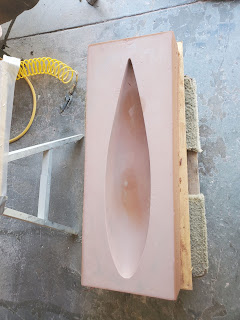Late Christmas and first screws
I haven't posted for a bit because, I think the day after the last post, I received my B&B Yacht Designs CNC plywood kit. Once it got here, I got super excited and started building as soon as I could.
Since I'm working closely with Hull 79, we pulled everything out of the crates and made sure that we both had all of the pieces. We did this because the crates weren't treated particularly well as they made their way across the US, and one had a fair hole punched in it, and the other was pretty well crushed, missing an end wall and had some of the contents stacked on top of the crate. But, we got lucky and nothing inside was damaged and there was nothing missing.
First up was building the strong back. This is a jig used for assembling the ring frames in the proper (hopefully close to perfect) orientation to start assembling stringers and hull plates. It's not a tough thing to build, but there are a couple of things to consider.
Start by always thinking about level, vertical and square. If you're building a boat, you're probably already pretty familiar with these concepts. Remember Pythagoras (3-4-5) for checking horizontal squares and keep things vertical with a good long level. Window shims (put them under horizontal members to adjust level) and a 4' level are almost mandatory here. A big carpenter's square is good too.
A chop saw will also save some time. Buy a cheap one if you have to, buy a good one if you can. If you're building a boat, chances are you'll build other things too, and the chop saw is a good add to a shop.
Converting between metric and inch standards isn't hard, but you WILL make a mistake and will kick yourself for it. Save yourself the headache and buy a GOOD metric tape measure if you don't already have one. You're welcome.
If there's any chance you'll have to move your strong back after assembly, consider putting adjustable legs on it. I welded some 3/4" coupling nuts onto a small piece of plate. With some 3/4" all thread, you can screw these plates to the strong back base and use them to adjust level when you move your kit around.
Use deck screws, not drywall screws. Drywall screws are brittle and will break. Deck screws can break but it's pretty unlikely.
Building the strong back isn't different than building most other things. Measure twice, cut once, and have fun. The more accurately you can build it, the less you'll have to fight with it later.
I had fun doing this. It was a good primer and got me thinking about building things in wood again. In the working world, I make things in metals and don't usually have to make things level and square to the world, only to itself. It's good to get back into woodworking again.






Comments
Post a Comment